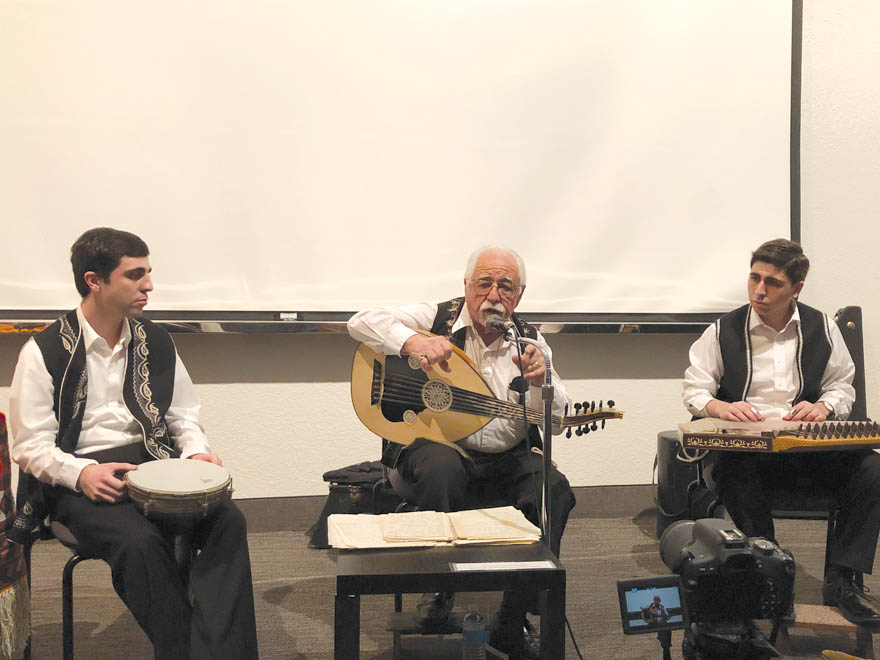Andrew Hagopian
Staff Writer

Central Valley native and award-winning oud-master Richard Hagopian gave a performance and lecture on Thursday, March 1, titled “Armenian Song Repertoire of the Middle East: Part II.” Accompanying him were his grandsons, Phillip and Andrew Hagopian, who were showcased on the kanun (the Middle Eastern Lap Harp) and the dumbeg (goblet shaped hand drum).
Dr. Partow Hooshmandrad, from the Department of Music at Fresno State, welcomed the audience and introduced Mr. Hagopian.
At 13, Hagopian started studying the oud with the internationally renowned Ar-menian artist Kanuni Garbis Bakirgian. He also learned the clarinet, the dumbeg, and the kanun, and mastered the accompanying musical theory, notation techniques, and both the classical and folk repertoires.
Hagopian has mastered the Armenian tradition in music by interviewing older Armenians he met at picnics and dances. His insight into how they celebrated, how they worshipped, how their instruments were made, and what dance steps were associated with the tunes of various geographical regions, gave him an unparalleled understanding of traditional Armenian music.
Hagopian’s presentation was co-sponsored by the Middle East Studies Lecture, Performance, and Film Series, the Armenian Studies Program, and the Global Music Lecture Series at Fresno State.
In Part I of this series, Hagopian had explained the oldest forms of Armenian music, whose roots are intertwined with the liturgical music of the Armenian Apostolic Church.
Hagopian added that the Armenian Church music is founded upon 8 melodic modes from which all other Armenian music evolved.
Hagopian in particular focused on the musical production of the oud, a non-fretted instrument, with 11 strings. The oud is an acoustical instrument made completely of wood and it was originally strung with catgut string or gut strings.
Hagopian then discussed how the styles of various oud-masters influenced his work. In particular, Hrant Kenkulian (Oudi Hrant) played a major role in Hagopian’s development as a musician. Hagopian first musical piece was a classical selection composed by Kenkulian called “Khrjeet.” The song reflects the blind oud master’s life and his love and appreciation of his wife. “We shouldn’t worry about how much they have and how little we have because someday, they will look upon our life and they will be jealous of our simple way of life,” said Hagopian.
Hagopian explained that it was primarily Armenian, Greeks, and Assyrians, who were the composers of Ottoman music. Among these, perhaps the best known was Tateos Ekserjian, or Kemani Tateos. Many of these composers and artists are now infrequently remembered.
The Hagopian trio performed another selection from the region of Eastern Armenia, “Bardezoom,” (In the Garden) composed in the classical era of traditional Armenian music by Ashough Sheram, a troubadour. When Armenia was ruled by kings and queens, troubadours would compose music in the courtyards of the palace and simultaneously write lyrics.
From one region of Armenia to the next, Hagopian took the audience on a journey from the areas of Erzerum, Dikranagerd, and back to Eastern Armenia.
Hagopian’s grandsons, Phillip and Andrew, were each given the opportunity to perform a piece on the oud. The two chose classical selections which honored the late Oudi Hrant. Phillip chose to play “Siroun Akhchig,” while Andrew performed “Parov Yegar, Siroun Yar.”
The audience showed its appreciation for the group by giving them a standing ovation, which led to an encore to conclude the evening.
 Hye Sharzhoom Armenian Action
Hye Sharzhoom Armenian Action